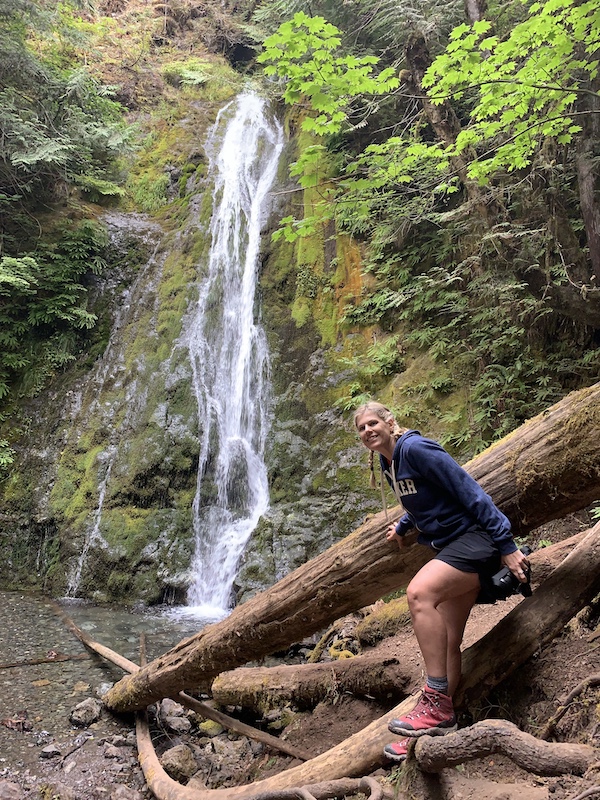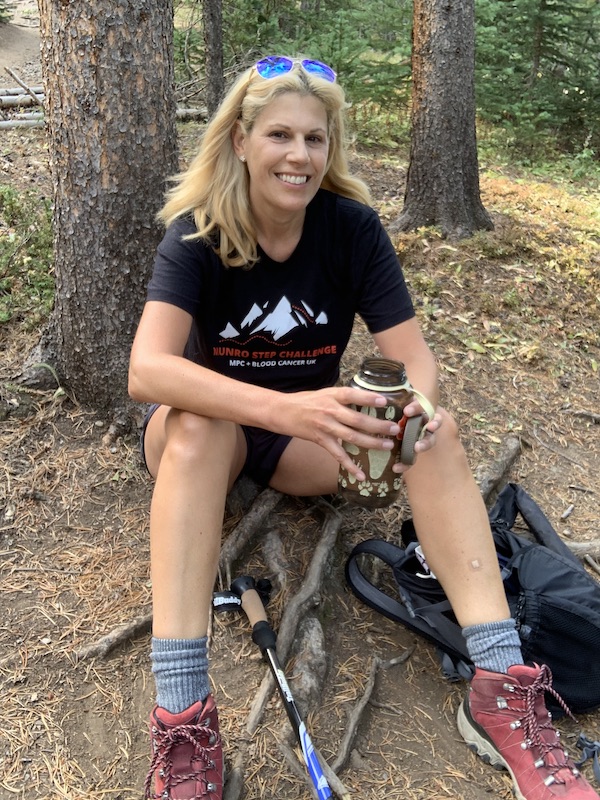Since I was a child, I have had a passion for spending time outdoors. I can recall a hiking trip I embarked on when I was 12 that involved my bicycling 25 miles to a lake area my folks took us to visit on camping trips. Packing nothing more than a thermos of Kool-Aid and a few PB&J sandwiches, I cycled the full 50-mile roundtrip ride, hiked the trails my father had shown me, and enjoyed a quiet lunch sitting with my feet dipped into the lake. I enjoyed it so much I enrolled other neighborhood kids to join me on a second expedition. While in college in Boston, I discovered a hiking area just outside the city: the Blue Hills. I’d spend my after-work hours shedding my traffic-packed commute for twilight walks, seeing fox, raccoon and deer come out of hiding for the night. Today, I happily wake early on a Saturday morning to head to the mountains for a nine-mile trek, finishing around lunch and then popping into a local dive for grub and a cider as my post-hike replenishment. My passion extends to my travels, as I’ve taken many trips to National Parks to hike and have even walked 100 miles across the Scottish Highlands.
While there is peace in spending time surrounded by nature, there is also an element of danger. On a recent spring hike that I mistakenly assumed was free of ice, I fell three times without my crampons or proper hiking poles and even had to climb a fallen tree to get across a creek filled with more water than I expected. These are not common occurrences but evidence of why hikers need to be prepared. Serious hikers often come across day trekkers who don’t understand the trails. Perhaps they have read one of our stories about waterfalls and hiking trails not to be missed and arrive, park and walk, often in sneakers, sometimes in flip-flops, and always without a pack. Too many waterfall seekers have slipped and seriously been injured by climbing wet rocks without the proper footwear, and other hikers have experienced heatstroke by not bringing more than a plastic water bottle for a hike that lasts more than an hour.
If you do them right, the North Georgia Mountains are filled with fantastic hikes to enjoy. Here’s what you need to know before and during your trek for a safe and healthy experience.

PACK THE PROPER GEAR
Before you get in your car to head for the hills, look up the area and trails you’ll be visiting. AllTrails is a helpful hiking app as it details hikes by length, elevation and difficulty, and hikers readily post updated their reviews. Read the reviews to see what recent hikers have recently encountered: Flooded areas, rock scrambles, natural steps, unkempt paths and more. Determine if you can handle the hike described or seek alternatives that may be more comfortable, then pick the right shoes for the job. Flip-flops should never be an option; not only do they lack the support your arches, toes and ankles need on uneven ground, but they also expose your feet to injury and lack traction.
Depending on the length of your hike, pack provisions: Enough water, snacks and a small emergency first aid kit are standard unless you’re doing a small trail that is less than a mile. Keep in mind that the average time to walk a mile is between 12 to 20 minutes, depending on your pace and the terrain. If you plan to follow a 5-mile trail, expect it to take just over an hour and a half to complete it, without any stops for photos or rests.
Hiking poles can help you traverse tricky spots and support your body on hills, but if you don’t have hiking poles, finding a sturdy walking stick at the trailhead could help. Often, hikers will leave sticks they found and used along their hike for others to use. I typically leave mine near trail maps.
Be mindful of the weather: If it’s a scorching day, bring extra water and consider electrolyte tablets. Pack a hat, bug spray, sunscreen, and bring a change of shoes in your car. When I complete a hike, I get out of my socks and hiking boots to let my feet rest and now’s the time you’ll find me in flip-flops for a more comfortable return drive or that aforementioned drop into a local eatery.
One more essential for your pack: toilet paper and plastic Ziplock bags so you can carry out your used toilet paper. (Yes, never leave it on the trail. Follow the Golden Rule and “Leave No Trace.”)
USE TRAIL MAPS
Being prepared means knowing where you’re going when you can’t locate a marker or get confused at a fork in a path. While some parks have maps at the trailheads, many do not, or you’ll find an empty map holder that park officials have yet to replenish. At the trailhead is not the time to find a map online, as it is most likely your cellular service won’t be working. Before you leave home or in an area with service, turn to AllTrails or state park websites to find trail maps, and then—this is important—download it to your phone, so you can access it without cellular service. It goes without saying that you should have a fully charged phone before you take one step on the trail. Putting it into airplane mode can help you save the battery, but at least turn off your cellular roaming, so your phone cannot search for service and drain the juice faster.
If you forget to find a map before you arrive and a trailhead map is featured in the parking area, take a photo of the map to zoom in on it and follow it if you get confused on the trail. Don’t rely on your phone to serve as your compass, either. A small compass in your pack can come in handy if you lose your sense of direction.
Originally created for hunters, onX Hunt is an incredible resource for hikers, too. For a minimal subscription fee, the app gives you access to highly detailed and accurate maps for public land, plus guidebook content, with the option to save offline maps to view on your smartphone without cellular service.

KNOW HIKING ETIQUETTE
One of my favorite parts of hiking is the silence, even when I walk with others. Of course, we chat when walking together but when you hike long distance, eventually you’ll fall into silence and just focus on where to place your next step and the views. Hiking is meditation to me, but you may want to listen to music as you hike. While you don’t want to wear earbuds so you can hear sounds around you and be alerted to people or animals nearby, you also don’t want to play your music so
loud that others can hear you coming and disrupt their silence.
If you encounter others as you hike, don’t sneak up behind someone as you pass. Be sure to give a hello as a heads up. When on a vertical portion of a trail, those climbing uphill have the right of way and those heading downhill should yield, as those going up have certain areas in which to place their footing and cannot easily make way as one descending can.
Bringing your pet on a hike is great and provides a sense of security if you are nervous about animal encounters but be sure to keep your pet leashed in the event someone—or something—surprises your pup and it takes off. Remember that other hikers may not be dog lovers and don’t want to meet your pet and don’t know how to handle an overly friendly or aggressive animal. As much as you think your pet will behave or listen on a trail, the leash will ensure it. Just remember, if you’re bringing your pet you’ll need extra water and treats.
Once again, Leave No Trace on the trail. Carry out any garbage from your hike, such as snack wrappers, used toilet paper and disposable water bottles. If you have a large enough pack and see some trash along your hike, feel free to grab it and help keep the trails beautiful.
TELL SOMEONE WHERE YOU WILL BE
For anyone choosing to hike solo, as I often do, the most crucial advice I can offer is to tell someone where you are hiking. Someone should know where you intend to hike, when you are starting and when you are expected to finish. And when you finish, be sure to send an update to that person so they know you are safe. If anything were to happen to you, someone needs to know you are missing to get you help. At state parks, check in at a visitor’s center or ranger station, let them know you’re solo, and accept any advice about the upcoming trail. Some difficult trails require hikers—solo or not—to register so rangers know who is out and about and are at the ready in the event of an emergency.
Another trick is to leave a note on your car’s dashboard with the trail you’re taking and your phone number. If you don’t make it back to your vehicle by dark, rangers will spot your car and know what trail to search.
Eager to try hiking? Start with short hikes until you (pun intended) get your footing. On a short trek, you can figure out what you didn’t need to take with you or what you weren’t prepared for so you can build familiarity and eventually take bigger hikes. Now that I know what I need, I restock my pack whenever I return from a hike so it’s ready to grab for my next adventure. This doesn’t mean I don’t forget something from time to time, but I’m more prepared than not when I find myself with a beautiful day and can hop in my car and set off to find happiness on the trails. Enjoy your trek!
WHAT TO BRING
Use this checklist to have the essentials every time you hike.
• Backpack
• Plenty of water and food
• Maps and compass
• First-aid kit and insect repellent
• Multi-tool
• Sun protection: Sunscreen, hat, sunglasses
• Toilet paper and Ziplock bags
• Headlamp with fresh batteries
• Fully charged cell phone
• Matches or lighter
• Hiking shoes and socks
• Weather-appropriate and moisture-wicking clothing
